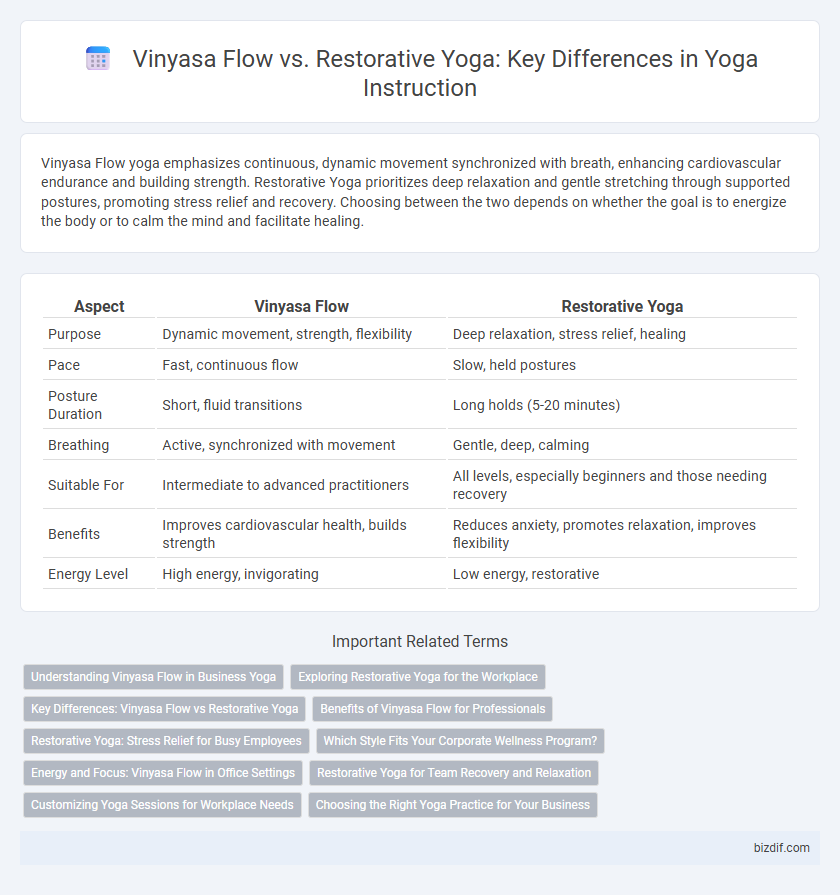Vinyasa Flow yoga emphasizes continuous, dynamic movement synchronized with breath, enhancing cardiovascular endurance and building strength. Restorative Yoga prioritizes deep relaxation and gentle stretching through supported postures, promoting stress relief and recovery. Choosing between the two depends on whether the goal is to energize the body or to calm the mind and facilitate healing.
Table of Comparison
| Aspect | Vinyasa Flow | Restorative Yoga |
|---|---|---|
| Purpose | Dynamic movement, strength, flexibility | Deep relaxation, stress relief, healing |
| Pace | Fast, continuous flow | Slow, held postures |
| Posture Duration | Short, fluid transitions | Long holds (5-20 minutes) |
| Breathing | Active, synchronized with movement | Gentle, deep, calming |
| Suitable For | Intermediate to advanced practitioners | All levels, especially beginners and those needing recovery |
| Benefits | Improves cardiovascular health, builds strength | Reduces anxiety, promotes relaxation, improves flexibility |
| Energy Level | High energy, invigorating | Low energy, restorative |
Understanding Vinyasa Flow in Business Yoga
Vinyasa Flow in business yoga emphasizes dynamic movement synchronized with breath, promoting energy, focus, and stress relief during work hours. This style enhances cardiovascular health and mental clarity, supporting productivity and resilience in corporate environments. Unlike restorative yoga's slow, passive stretches, Vinyasa Flow engages active transitions that invigorate employees while fostering mindfulness.
Exploring Restorative Yoga for the Workplace
Restorative Yoga offers a gentle, stress-relieving practice ideal for the workplace, utilizing props like bolsters and blankets to support deep relaxation and enhance mental clarity. Unlike the dynamic sequences of Vinyasa Flow, Restorative Yoga emphasizes slow, mindful poses held for extended periods, promoting recovery and reducing anxiety in high-pressure office environments. Incorporating Restorative Yoga sessions into the workday can improve employee well-being, increase focus, and boost overall productivity.
Key Differences: Vinyasa Flow vs Restorative Yoga
Vinyasa Flow emphasizes dynamic, continuous movement linking breath with transitions, promoting cardiovascular endurance and muscular strength. Restorative Yoga centers on passive poses held for extended periods, using props to encourage deep relaxation and stress relief. The key difference lies in Vinyasa's active flow versus Restorative's focus on stillness and recovery.
Benefits of Vinyasa Flow for Professionals
Vinyasa Flow enhances cardiovascular health and increases muscular strength, making it ideal for professionals seeking dynamic exercise within limited time. The continuous, breath-synchronized movements improve focus, mental clarity, and stress management, crucial for high-pressure work environments. Consistent practice also boosts stamina and flexibility, promoting overall well-being and resilience against workplace fatigue.
Restorative Yoga: Stress Relief for Busy Employees
Restorative Yoga offers a gentle, stress-relieving practice designed to calm the nervous system and enhance relaxation, making it ideal for busy employees facing high-pressure work environments. Unlike Vinyasa Flow's dynamic sequences that build strength and endurance, Restorative Yoga uses passive poses supported by props to promote deep muscle relaxation and mental clarity. Incorporating Restorative Yoga into a daily routine reduces cortisol levels, improves sleep quality, and fosters resilience against workplace stress.
Which Style Fits Your Corporate Wellness Program?
Vinyasa Flow promotes dynamic movement and cardiovascular benefits, making it ideal for corporate wellness programs seeking to boost energy and improve overall fitness levels. Restorative Yoga emphasizes deep relaxation and stress relief, supporting mental clarity and reducing workplace burnout. Evaluating employee needs and organizational goals helps determine whether an active or calming yoga style best fits your corporate wellness strategy.
Energy and Focus: Vinyasa Flow in Office Settings
Vinyasa Flow yoga in office settings boosts energy levels by synchronizing breath with dynamic movement, enhancing blood circulation and mental alertness during work hours. The continuous flow of poses cultivates focus and reduces stress, making it ideal for maintaining productivity and combating afternoon slumps. Unlike Restorative Yoga's passive approach, Vinyasa Flow actively energizes the body and sharpens concentration, supporting sustained cognitive performance.
Restorative Yoga for Team Recovery and Relaxation
Restorative Yoga promotes team recovery and relaxation by utilizing gentle, supported poses that activate the parasympathetic nervous system, reducing stress and enhancing mental clarity. Unlike the dynamic sequences in Vinyasa Flow, Restorative Yoga emphasizes prolonged holds and deep breathing to facilitate muscle relaxation and emotional balance. This practice improves focus and cohesion within teams, making it ideal for workplace wellness and post-activity recovery.
Customizing Yoga Sessions for Workplace Needs
Vinyasa Flow emphasizes dynamic, continuous movement that enhances cardiovascular health and energy levels, making it ideal for workplaces seeking to boost employee vitality and focus. Restorative Yoga centers on gentle, supported poses that promote deep relaxation and stress reduction, benefiting office environments where mental calmness and recovery are prioritized. Customizing yoga sessions by integrating Vinyasa Flow for active engagement and Restorative Yoga for relaxation ensures balanced wellness tailored to diverse workplace needs.
Choosing the Right Yoga Practice for Your Business
Vinyasa Flow emphasizes dynamic movement and breath synchronization, ideal for fitness-focused businesses aiming to attract energetic clientele seeking cardiovascular benefits and strength-building. Restorative Yoga offers gentle, supported poses promoting deep relaxation, making it suitable for wellness centers targeting stress relief and mental well-being. Understanding your target audience's goals helps tailor your yoga offerings to increase client retention and satisfaction.
Vinyasa Flow vs Restorative Yoga Infographic

 bizdif.com
bizdif.com